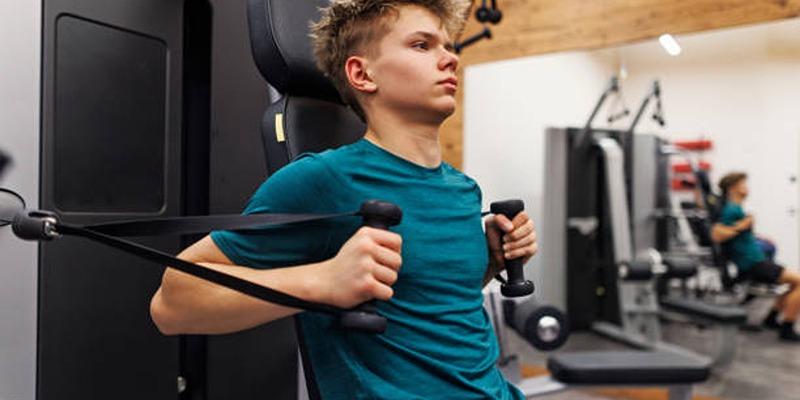Youth fitness and resistance training are essential components of building a strong foundation for lifelong health. These practices help improve strength, agility, and overall physical well-being while also enhancing confidence and discipline. When implemented safely and appropriately, resistance training can be highly beneficial for young individuals, fostering healthy habits that last well into adulthood.
Benefits of Youth Fitness and Resistance Training

Engaging in regular physical activity offers numerous benefits for young individuals, including:
1. Improved Strength and Muscle Development
The process of developing lean muscle mass highly depends on integration of resistance training methods like weightlifting or bodyweight exercises in one’s regimen. It increases the ease of day to day activity while nurturing growth through strengthening and building stamina on muscles. Apart from enhancing athletic capabilities, this tact influences preservation of the functional fitness as you age.
2. Enhanced Bone Health
It is recommended to perform weight-bearing activity like running or jumping or the usage of weight in order to build stronger bones. These exercises help in depthens the process of bone density, reduce fracture risks and help prevent such diseases as osteoporosis later in life. Better posture and stability in general are the result of having stronger bones.
3. Better Cardiovascular Health
Regular engagement in the activities as common as aerobic exercises or interval training may promote the wellbeing of the heart by strengthening it and increasing the flow of blood. This makes healthy blood pressure, reduction in bad cholesterol, and reduction of risk of heart disease, all advantages. Such exercise also contributes to better energy levels, feeling active and vital.
4. Mental Health and Cognitive Benefits
Exercise releases endorphins, also known as feel-good hormones, which help reduce stress, anxiety, and symptoms of depression. Beyond emotional well-being, physical activity improves focus, memory, and cognitive performance. Regular movement has been linked to enhanced academic achievement in children and improved productivity in adults, making it a mental and emotional win-win.
5. Healthy Weight Management
Physical activity is essential for managing a healthy weight. Exercise increases metabolism, helping the body burn excess calories more efficiently. It also builds muscle, which further promotes fat loss and long-term weight regulation. A balanced exercise routine combined with healthy eating habits ensures lasting results in maintaining an ideal weight.
Understanding Resistance Training for Youth
Resistance training focuses on building muscular strength and endurance by challenging the muscles with external forces. This can involve a variety of methods, such as bodyweight exercises, free weights, resistance bands, or weight machines, each offering unique benefits for improving overall fitness.
Debunking Myths About Youth Resistance Training
1. "Resistance Training Stunts Growth"
The idea that resistance training hampers a child’s growth is one of the most persistent myths. However, research decisively shows that, when performed with proper technique and supervision, strength training has no adverse effect on growth plates or overall height.
2. "Kids Should Only Do Cardio"
Cardio is essential for overall health, but resistance training offers unique benefits that go beyond aerobic activity. It enhances muscular strength, improves stability, and helps prevent injuries, making it a valuable addition to any child’s fitness routine.
3. "Resistance Training Is Only for Teen Athletes"
Strength training isn’t just for young athletes. Children of all activity levels can benefit from increased muscle strength, better coordination, and improved performance in everyday tasks and play.
Safe and Effective Resistance Training Guidelines
To ensure safety and effectiveness, follow these key principles:
1. Start with Proper Warm-Up and Cool-Down
Always begin your workout with a dynamic warm-up, such as jogging, jumping jacks, or arm circles. This increases your heart rate, improves blood flow to your muscles, and reduces the risk of injury. After your workout, take time for static stretching, holding each stretch for 15-30 seconds to enhance flexibility and promote muscle recovery.
2. Focus on Technique Over Weight
Mastering proper form is key to avoiding injuries and getting the most out of your exercise routine. Beginners should prioritize learning the correct technique for each movement before adding weight. Start with bodyweight exercises or light resistance, slowly increasing intensity as your form improves and your muscles adapt.
3. Age-Appropriate Exercises
- Ages 7-12: Focus on bodyweight exercises like push-ups, squats, or lunges, which build strength without overloading growing joints. Light resistance bands can also be introduced for added variety and challenge. Fun activities like climbing, jumping, or sports can also build strength naturally.
- Ages 13-18: At this stage, free weights and machines can be incorporated into workouts, but it’s essential to train under proper supervision to ensure safety and correct form. Encourage teens to focus on foundational strength-building exercises like bench presses, deadlifts, and pull-ups to develop balanced strength.
4. Balanced Workout Routine
A well-rounded workout targets all major muscle groups – legs, chest, back, arms, shoulders, and core. This ensures balanced muscle development and reduces the risk of muscle imbalances, which can lead to injuries. For example, pair leg exercises like squats and lunges with upper-body routines like push-ups and rows. Don’t forget core-focused exercises like planks and twists to improve stability and overall performance.
5. Adequate Rest and Recovery
Rest is just as important as exercise for building strength. Give your muscles at least 48 hours to recover between sessions targeting the same muscle group. This allows time for muscle repair and growth. Overtraining not only increases the risk of injury but can also lead to fatigue, burnout, and decreased motivation. Ensure proper sleep and hydration to support recovery and overall performance.
Best Resistance Training Exercises for Youth
Here are some effective exercises categorized by difficulty:
Beginner Exercises
- Bodyweight Squats – Strengthens legs and core.
- Push-Ups – Builds upper body strength.
- Planks – Enhances core stability.
Intermediate Exercises
- Dumbbell Rows – Strengthens back muscles.
- Lunges – Improves leg strength and balance.
- Resistance Band Pull-Aparts – Enhances shoulder and upper back strength.
Advanced Exercises
- Deadlifts (Light Weight) – Develops full-body strength.
- Bench Press (With Supervision) – Builds chest and arm muscles.
- Pull-Ups – Strengthens back and arms.
Nutrition for Youth Fitness
A balanced diet supports muscle growth and recovery. Key nutritional tips include:
- Protein for Muscle Repair- Include lean meats, eggs, dairy, beans, and nuts in meals.
- Carbohydrates for Energy- Whole grains, fruits, and vegetables provide sustained energy for workouts.
- Healthy Fats for Joint Health- Avocados, nuts, and olive oil support overall health.
- Hydration is Essential- Drink water before, during, and after exercise to prevent dehydration.
Common Mistakes to Avoid
- Skipping Warm-Ups – Failing to warm up properly increases the risk of injury.
- Lifting Too Heavy, Too Soon – Jumping into heavy weights too quickly can compromise form and lead to injuries.
- Ignoring Rest Days – Overtraining without adequate recovery can stall progress and strain your body.
- Poor Nutrition – Insufficient or unbalanced nutrition hinders recovery and overall performance.
Creating a Sustainable Fitness Routine

Consistency is key. Follow these steps:
- Set Realistic Goals – Short-term and long-term targets keep motivation high.
- Track Progress – Maintain a workout log to monitor improvements.
- Stay Motivated – Work out with friends or join fitness classes for accountability.
- Listen to Your Body – Adjust workouts if experiencing pain or fatigue.
Conclusion
Youth fitness and resistance training offer immense physical and mental benefits when done correctly. By following proper techniques, maintaining a balanced diet, and staying consistent, young individuals can build a strong foundation for lifelong health and fitness. Always consult a fitness professional or healthcare provider before starting a new exercise program to ensure safety and effectiveness.












